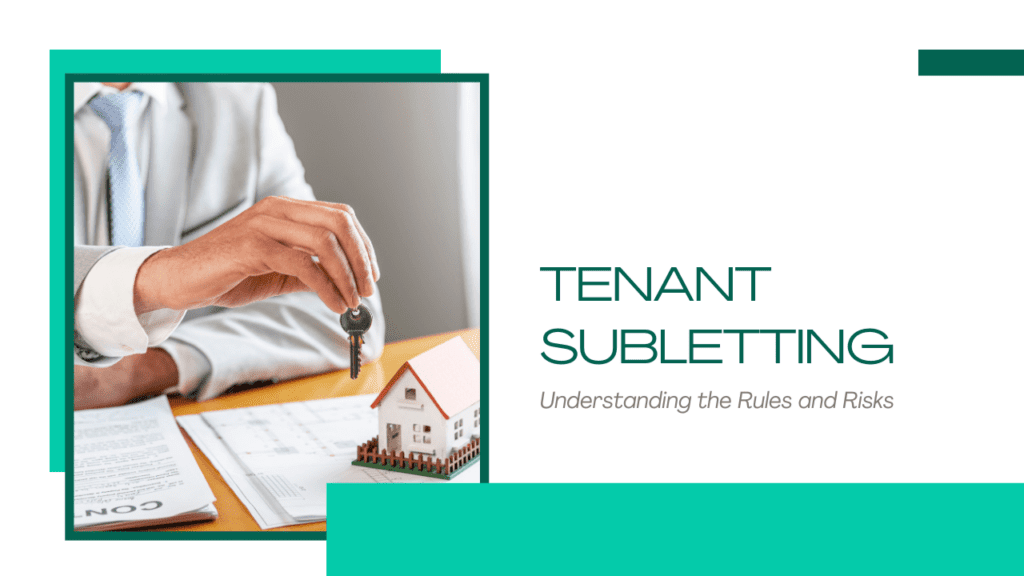
As all we know, Los Angeles has always been a competitive and expensive rental market. If you’re renting out a property in LA, you need to be flexible, creative, and willing to work with situations and ideas that might not be possible in other markets.
For rental property owners in LA, understanding the rules and the risks associated with tenant subletting is an important part of effectively keeping your property occupied and rent consistently coming in. Subletting occurs when a tenant rents out their leased premises—or part of it—to another person, referred to as the subtenant. Your tenant is still the tenant of record and bound by the lease agreement.
In LA, rental agreements are complex, state and local laws are strict, and several details need to be managed from leasing signing to move-out. Tenants are mobile, and their needs are always changing. You might sign a one-year lease and find yourself working with a tenant who needs to move and wants to sublet. Or, your existing tenant might want to sublet part of the home to a roommate who was not approved at the beginning of the lease term.
It’s a challenging topic, especially if you are generally opposed to allowing tenants to sublet. However, we have assisted Los Angeles landlords in making informed decisions and subletting their homes in the past, and we are happy to help you navigate this process if you find yourself needing to sublet a property that your current tenant needs to vacate.
Why Subletting?
This arrangement can be appealing for tenants who wish to reduce their rent burden or need to leave town for an extended period without relinquishing their lease. On the other hand, from a landlord’s perspective, it can introduce a level of uncertainty regarding who is occupying the property and how you can best protect it.
Understanding the Rules
What does subletting look like for your LA rental property? That depends on the property itself and the current lease agreement you have in place. It depends on what that tenant needs and wants from you.
The first step in managing subletting situations is to look at your lease agreement. This is where everything on your rental property and your relationship with tenants must begin. Most leases include clauses that address subleasing, and these usually require the landlord’s consent before the process can proceed.
In Los Angeles, the Rent Stabilization Ordinance (RSO) further impacts these clauses, providing tenants with certain protections that landlords must be aware of. You cannot charge the subletting tenant more than you are charging the existing tenant and also cannot raise the rent because another person is moving into the property.
Under California law, unless the lease specifically prohibits subletting, tenants may have the right to sublease their rental unit. In this case, you would not be able to unreasonably withhold consent. If you are certain that you will not want your tenants to sublease the property they’re renting under any circumstances, you’ll want to make sure your lease agreement prohibits it.
Assessing the Risks and Benefits of Subletting
As long as you’re able to screen and approve the additional tenant or the new tenant who will be moving in for part of your existing tenant’s lease, you shouldn’t have too much of a disruption when a subletting situation occurs.
There are plenty of good reasons to allow your tenants to sublet. It may prevent them from breaking the lease entirely. It may keep them able to continue paying rent. Consistent income is essential when you’re renting out an LA property; you don’t want to find yourself in a situation where tenants feel like they have nothing to lose. That’s when they’ll stop paying rent or move out without notice.
However, it’s not always an ideal situation. Subleasing can pose several risks to you and your rental property, including:
- Unknown Tenants: The subtenant might not go through the usual vetting process, raising concerns over their reliability and financial stability. You can prevent this from requiring a standard screening process when a tenant wants to sublet. You should hold the new tenant to all the same standards that you have in place in your existing rental criteria.
- Property Wear and Tear: More occupants living on your property could increase the wear and tear on the property. You might find there’s more deterioration and an increase in maintenance requests throughout the tenancy.
- Legal Liability: The original tenant still holds the lease agreement, but issues like non-payment of rent or property damage may complicate matters. Things can get complicated when you’re trying to enforce your lease with the tenant who is subletting rather than the tenant who signed the initial lease agreement.
To mitigate these risks, here is what we recommend when a tenant wants to sublease your LA rental home:
- Require Prior Approval: Clearly state in the lease agreement that subleasing is only permissible with prior approval from you.
- Screen Subtenants: Treat subtenants like any other new tenant. Conduct background and credit checks.
- Amend Lease Agreements: Adjust the lease to reflect the new living situation and ensure that all provisions comply with local laws.
- Communication: Maintain open lines of communication with your tenants about your expectations and their responsibilities when subleasing.
Tenant subletting doesn’t always have to be a source of anxiety and frustration for landlords in LA. With clear lease provisions, knowledge of the law, proper tenant screening, and open communication, you can manage your property effectively while accommodating subleasing requests.
 You might find situations such as subletting are much easier to manage when you’re partnered with a professional property manager in Los Angeles. Not only do we have an excellent understanding of the law, but we also work with lease agreements designed to protect you and your investment property.
You might find situations such as subletting are much easier to manage when you’re partnered with a professional property manager in Los Angeles. Not only do we have an excellent understanding of the law, but we also work with lease agreements designed to protect you and your investment property.
Every rental situation is unique, and we can help you craft a strategy that works well for your particular property or portfolio of properties. Contact us at Earnest Homes.
